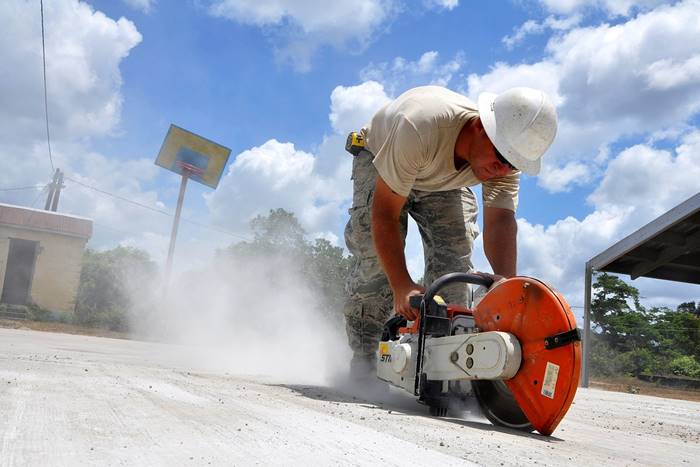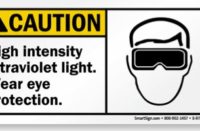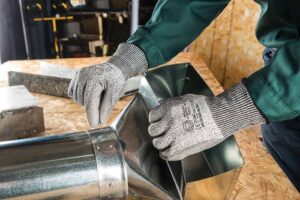
Crystalline silica refers to a naturally occurring class of minerals found in a wide variety of rock. This mineral occurs naturally in virtually all sedimentary, metamorphic and igneous rocks including granodiorites, rhyolites and granites. Its most common form is quartz, which is the second most abundant mineral harvested from the Earth’s crust.
Crystalline silica, the “crystalized” dust and airborne particulates of quartz, also occurs naturally in sand, soil and granite. Harvested and pulverized quartz and other rocks containing crystalline silica are often used as components of concrete, mortar, grout, brick, masonry, asphalt and other materials regularly used in construction.
Workers who commonly cut, drill, chop, grind or demolish any of these materials are at greater risk to airborne silica exposure. It’s harmful to their health if they inhale the fine fraction of the dust.
The general population may be exposed through art supplies and household items from cosmetics and cleansers to household abrasives and adhesives. Abrasive blasting during paint or rust removal, as well as glass etching, can also create airborne silica.
Beware of the dangers of exposure
According to the Centers for Disease Control and Prevention, each year millions of workers across the U.S. are exposed to dangerous respirable crystalline silica. This form of silica, often abbreviated as RCS, is the primary reason for increased risk and the need for preventative measures.
Exposure poses a serious health risk to workers across a broad range of industries including high-risk professions such as construction, stone or mason cutting, rock and quarry drilling, abrasive blasting and foundry work, to name a few.
The National Cancer Institute classifies crystalline silica as a human lung carcinogen, as well as a serious health risk for other conditions such as silicosis. Silicosis is a preventable but irreversible disease associated with exposure to respirable silica dust.
Other conditions associated with crystalline silica exposure include pulmonary tuberculosis, a variety of debilitating and potentially fatal airway diseases, autoimmune diseases and kidney damage.
Crystalline silica damages lungs
According to the American Lung Association, crystalline silica damages the lungs by causing permanent scarring, clinically referred to as pulmonary fibrosis.
When respirable silica enters the airways it makes its way to the lungs where it initiates an inflammatory response. This inflammatory response, over time, causes the formation of nodules and scarring that makes it increasingly difficult for individuals to breathe normally.
This scarring, known as silicosis, can lead to tuberculosis, chronic bronchitis, autoimmune disorders, kidney damage and lung cancer. It’s a progressive disease that typically presents 10-30 years post-exposure. Over time, individuals may notice a significant decrease in lung capacity and may eventually require oxygen or devices to help them breath.
Although exposure may increase the risk of other forms of cancer, lung cancer is the most pronounced.
A study published in the “Journal of Occupational and Environmental Medicine” determined that exposure to RCS was a reliable predictive factor in determining an increased chance of developing lung cancer.
The study also reported the death rate predicted was 1.6 times that of those with no exposure, with models showing the onset of the disease took 10+ years to show itself.
Symptoms of crystalline silica exposure
According to the American Lung Association, symptoms associated with silicosis typically begin to show years after exposure. These symptoms may include a shortness of breath that gets worse over time, a mild but recurring or persistent cough that won’t go away, and coughing up sputum, a saliva and mucus mixture.
Progressive lung scarring may also result in weakness, fatigue, fever and night sweats. People with this disease may have leg swelling and a bluish discoloration of the lips. They often experience bronchitis-like symptoms and have difficulty breathing.
In the later stages of silicosis, these symptoms worsen. Diagnostic tests such as chest X-rays or a CT scan are used to reveal the underlying condition.
Types of silicosis
Silicosis is medically classified in three distinct categories.
Chronic/classic silicosis: The most common form, this type typically presents itself after 15-20 years of low-to-moderate exposure. Symptoms of chronic silicosis are generally mild and less noticeable. This means that often diagnosis does not come until the disease has progressed.
Accelerated silicosis: As the name suggests, this type is more aggressive than chronic silicosis. It presents itself around five to 10 years post-exposure. High levels of exposure generally causes this type of silicosis.
Acute silicosis: The most aggressive of forms, acute silicosis typically presents itself within months to two years post-exposure to very high levels of RCS.
Treatment options
Currently, there’s no cure for silicosis. Damage caused by RCS exposure is permanent and irreversible. However, there are treatments that may be used or prescribed to mediate symptoms and slow down progression.
Options include using a bronchodilator or portable oxygen tanks. People may also enroll in a pulmonary rehabilitation program. Those afflicted should stop smoking, limit smoke exposure and live a healthy lifestyle. In extreme cases, people may qualify for a lung transplant.
Proper safety measures
Because the damage caused by exposure is irrevocable, prevention is key. Both the Occupational Safety and Health Administration and the Mine Safety and Health Administration have specific regulations regarding the use, transport and handling of silica.
One of the best preventative measures when working with or around silica is to use personal protective equipment. Specifically constructed PPE that’s properly fitted and maintained is critical to reducing risk. As it relates to silica exposure, masks with proper ventilation are the primary form of PPE.
It is a requirement of employers to provide adequate training on the use of PPE. It is also a required to train employees on how to handle hazardous materials.
Training regarding PPE generally covers the requirements, when it to use it and its limitations. Also included is how to properly fit and adjust PPE, as well as PPE care, maintenance and disposal.
In addition to the above, there are other safety measures both employees and employers can take:
- Limit the use of silica materials by replacing them with alternative materials.
- Install exhaust ventilation and separate blasting cabinets.
- Reduce dust with control measures such as water sprays.
- Use N95 NIOSH-certified respirators when respiratory protection is necessary.
- Use only Type CE abrasive-blast supplied-air respirators for abrasive blasting.
- Wear disposable or washable clothing.
- Shower or clean immediately after work is complete.
- Don’t drink, smoke or eat in areas where silica dust is present.
















